Capillary isoelectric focusing (CIEF) is a high resolution seperation technique that seperates biomolecules based on their pI point. Whole column imaging detection (WCID) provides real-time images of the entire capillary during the seperation process. The main benefit of CIEF-WCID is that the mobilization step required for single point detection is eliminated thus improving seperation resolution and throughput. Both UV absorbance and LIF detection schemes can be used with WCID. In co-operation with an industrial partner, Convergent Biosciences, several PDMS based chips were developed to improve the operation of their commericial CIEF-WCID system.
The first part of this project studied the benefits of switching from a capillary based format to a rectangular PDMS microchannel chip (see figure below). The PDMS format was easier to fabricated and cost significantly less compared to the commerical cartridge currently in use.
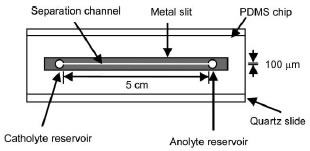
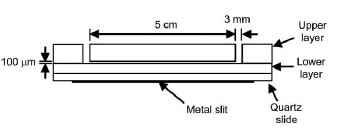 Schematic of the PDMS CIEF-WCID chip consisting of a straight microchannel 100µmx 100µm. The metal slit is aligned over the microchannel to improve the detection sensitivity of the UV absorbance.
Schematic of the PDMS CIEF-WCID chip consisting of a straight microchannel 100µmx 100µm. The metal slit is aligned over the microchannel to improve the detection sensitivity of the UV absorbance.
A side-by-side comparison was made between the PDMS chips and the commercial cartridge. The overall performance of the PDMS chip was found to be comparable in terms of EOF magnitude, pH gradient linearity, peak capacity, separation resolution, speed, and reproducibility. The figure below (Left) shows the CIEF profiles of human haemoglobin control AFSC in the PDMS chip and the commerical cartridge. An added benifit of using rectangular microchannels is that the UV absorbance detection capabilities can be improved. Rectangular microchannels eliminate the lens effect that occurs when a rounded surface is used, as well, the light path can be increased by using high-aspect ratio channels (height to width) which improves the detection sensitivity as shown below (Right).
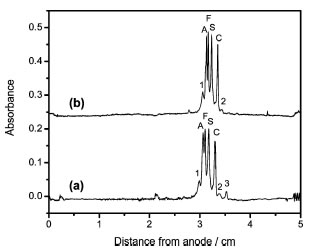
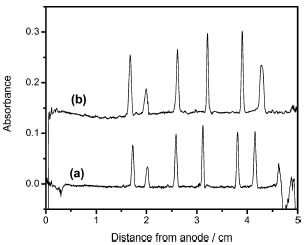
CIEF profiles for human haemoglobin control AFSC on (a) PDMS chip and (b) commercial cartridge (Left). Profile for six pI markers in PDMS microchannels (a) 200µmx 50µm (hxw) and (b) 250µmx 40µm which shows a 24% improvement in peak height which is in good agreement with the increase in light path 25% (Right).
In the second part of the project dialysis membranes were integrated into the chip in order to prevent cross-contamination between the electrolytes and sample. This design also helps reduce undesired pressure driven flow and improves sample injection. The fabrication uses a novel stamping method to seal the membranes between two layers of PDMS. The new chip produces more repeatable results and can be easily integrted with automatic sample injectors.
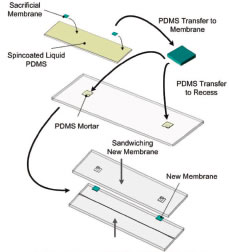
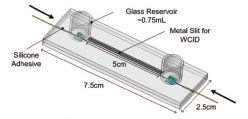
Fabrication procedure for integrating the dialysis membranes (Left). Completed CIEF-WCID PDMS cartridge with inserted capillaries for sample injection.
The PDMS dialysis membrane cartridge was extensively tested to characterize the performance compared to the commerical cartridges. Human haemoglobin control AFCS and myoglobin were successfully seperated on the chip as shown below. The astericks indicate unknown isoforms that were detected by the PDMS chip.

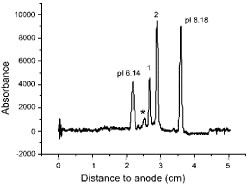
For more information on these projects please refer to the following publications: